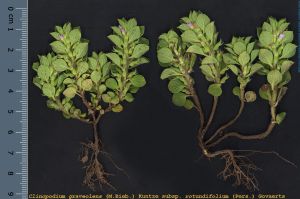Clinopodium graveolens (M.Bieb.) Kuntze subsp. rotundifolium (Pers.) Govaerts
Family: LABIATAE (LAMIACEAE)
Genus: Clinopodium
Sinònims: Acinos rotundifolius Pers. Ziziphora rotundifolia (Pers.) Melnikov
Catalan common name: Calaminta de secà.
Spanish common name: Calaminta de secano.
Province distribution: Alacant. Castelló. Lleida. Tarragona. València.
General distribution (Phytogeography): Mediterranean Irano-Turanian
IUCN Category: Not evaluated
Flowering time: JanFebMarAprMayJunJulAugSepOctNovDec
Life-forms: Terophyte.
Habitats: Cultivated fields, path and road sides, disturbed zones. Therophytic calicole fields. Rocky surfaces and dry stone walls. Annual dry grasslands on calcareous or marly substrates, occurring in scrub clearings or along crop margins in moderately moist mountainous areas.
Characteristics: Annual aromatic herb, 5-25 cm tall, sparsely covered with short retrorse hairs (directed toward the base). Leaves 5-25 mm long, petiolate, elliptic to ovate, with 2-3 pairs of teeth in the upper half, sparsely hairy. Inflorescence composed of verticillasters bearing 2-6 flowers. Bracteoles linear. Calyx green and pubescent, with pronounced veins, ventricose at the base and narrowed at the apex, bearing five unequal linear apical teeth. Corolla 7-9 mm, violet or pink.
Observations: This species may be confused with Ziziphora aragonensis Pau. The hook-shaped hairs are very characteristic of Ziziphora, whereas in C. graveolens they are somewhat straighter, shorter, and finer. Furthermore, in C. graveolens, the calyx teeth are clearly asymmetric, with three above and two below, unlike in Z. aragonensis, where they are all more uniform. And, above all, at fruiting, although also during flowering, the calyx closes in Z. aragonensis, remaining open in C. graveolens.

